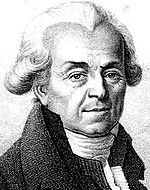Barthélemy Faujas de Saint-Fond
Barthelemy Faujas de Saint- Fond ( born May 17, 1741 Montelimar, † July 18, 1819 ) was a French geologist and volcanologist. Faujas de Saint Fond was with Déodat Gratet de Dolomieu (1750-1801) one of the first in France, published new research on volcanoes and volcanic rock. The mineral faujasite is named after him.
Life
Barthelemy Faujas de Saint- Fond received his education at a Jesuit College in Lyon and later studied law in Grenoble. There he was admitted as a solicitor to the Parliament. He was seneschal at the court in 1765 Montelimar, where he earned high praise. In his spare time, he explored the mountains of the Alps and the Massif Central. There he began his studies of the form and structure of rocks.
In 1775 he was in a Velay pozzolan deposit, which was later dismantled by the government. In 1776 he established relations with the Count of Buffon, who recognized the value of his scientific work immediately. Invited by Buffon to Paris, Faujas finished his work as a lawyer and was founded by Louis XVI in Muséum national d' assistant Histoire Naturelle ( Natural History Museum ) appointed in Paris. Later he became a Royal Commissioner of Mines.
One of his most important works is Recherches sur les volcans éteints you Vivarais et du Velay ( studies of the extinct volcanoes in Vivarais and Velay ), which was released in 1778. This publication documents his close observation, from which he developed a theory on the origin of volcanoes. In his capacity as Commissioner of Mines, he traveled to most European countries and examined the spot the rocks in their natural environment. Faujas was the first to recognize the volcanic origin of the basaltic columns of Fingal 's Cave on the island of Staffa in Scotland.
1785 Faujas was appointed Royal Commissioner for factories, armories and royal forests. This earned him an income of 4000 livres and 2000 livres as travel expenses in addition to his salary of 6000 livres as an assistant of Natural History.
Faujas in 1793 was appointed professor of geology at the Jardin des Plantes, a post he held until he was 80 years. In 1818 he retired to his country estate Saint- Fond in the Dauphiné.
Faujas was particularly interested in the balloon experiments of the Montgolfier brothers and also published a very thorough work in two volumes, the Description of expériences de la machine aerostatique de Montgolfier MM, & c. ( 1783-1784 ). He also contributed many papers to the Annales and the Mémoires from the Natural History Museum. More of his works are Histoire naturelle de la province de Dauphiné (1787, 1782 ), mineralogy of volcans ( 1784) and Essai de géologie ( 1803-1809 ).
Works (selection)
- Physical treatise on the Trapp. Publishing the Academic Bookstore, Strasbourg 1789 ( Original title: Essai sur les roches de Trapp ) (online).
- Description of expériences de la machine de aerostatique MM de Montgolfier et celles de cette auxquelles découverte a donné lieu, suivie de recherches sur la hauteur à laquelle est parvenu le ballon du Champ -de- Mars .. etc.. 1, Cuchet, Paris 1783 ( french, online).
- Description of expériences de la machine de aerostatique MM de Montgolfier et celles de cette auxquelles découverte a donné lieu, suivie de recherches sur la hauteur à laquelle est parvenu le ballon du Champ -de- Mars .. etc.. 2, Cuchet, Paris 1783 ( french, online).
- Mémoire sur la manière de reconnaître les différentes espèces de pouzzolane, et de les employer dans les constructions dans l' eau et hors de l' eau pour servir de suite. Nyon, Amsterdam 1780 ( french, online).
- Mémoire sur des bois de cerfs fossil, trouvé en creusant un Puits dans les environs de Montelimar en Dauphiné. J. Cuchet, Grenoble 1776 ( french, online).









